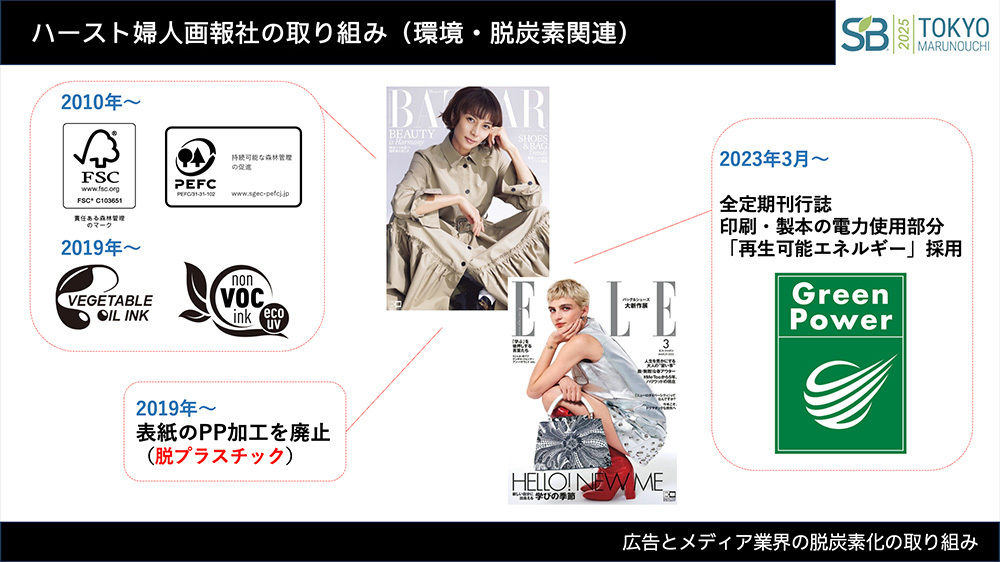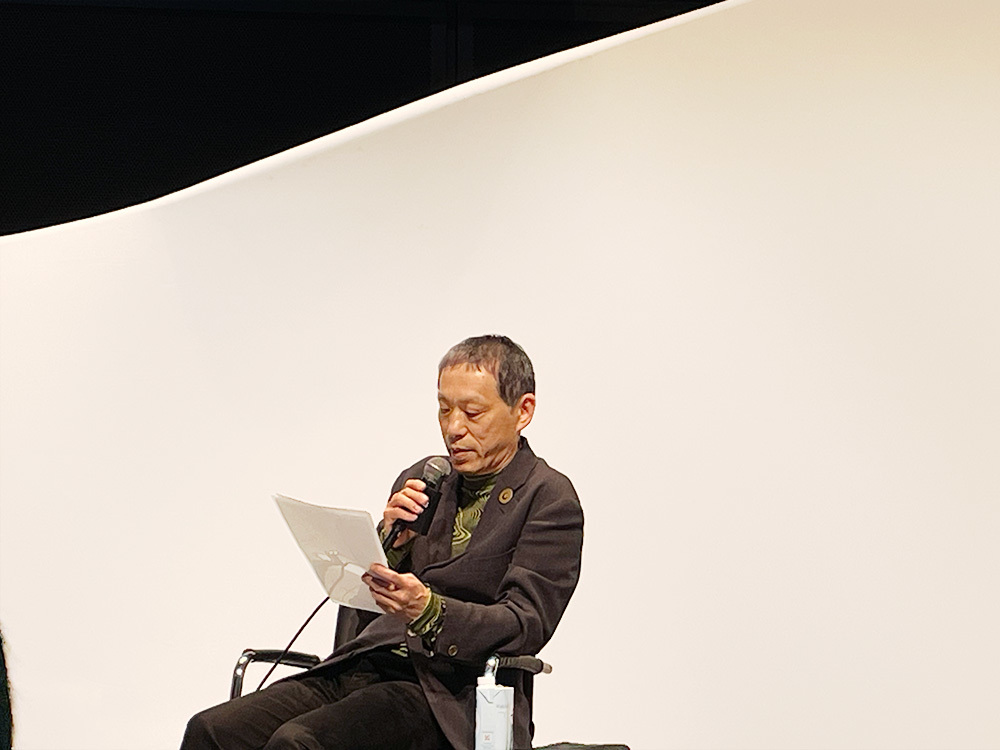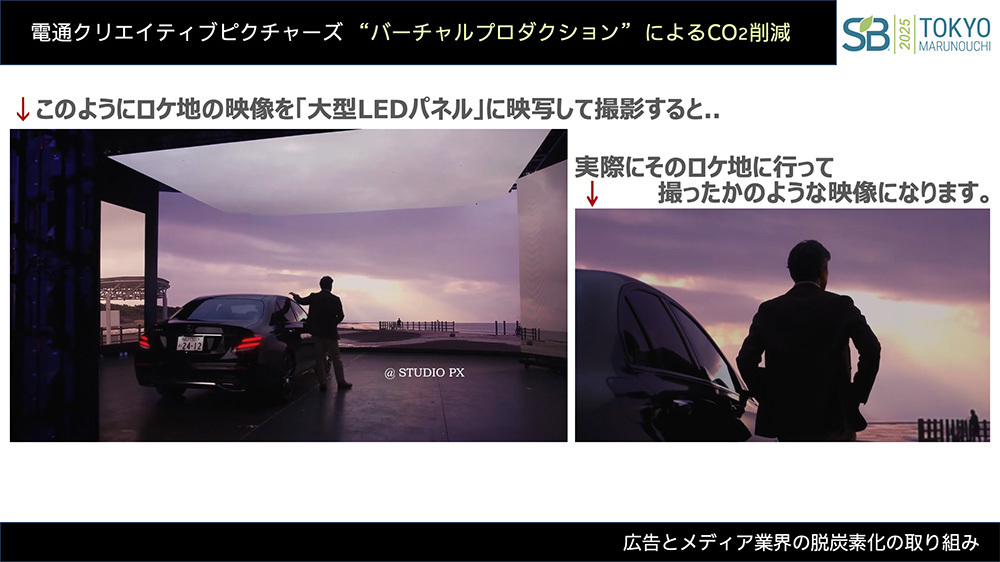The 9th Sustainable Brands International Conference 2025 Tokyo Marunouchi was held on March 18-19, 2025. The Sustainable Brands International Conference is a community event held worldwide, bringing together leaders involved in sustainability. This year's theme was "Breakthrough in REGENERATION," aiming for further innovation towards the regeneration of business and society.
The session titled "Decarbonization Initiatives in the Advertising and Media Industry: The Responsibility and Potential of Sustainability Promotion" was facilitated by Rie Takeshima of Dentsu Inc. Speakers included Hiroko Ohtake of Hearst Fujingaho / Hearst Digital Japan and Toru Hasegawa of Dentsu Creative Pictures Inc. They discussed decarbonization initiatives within the advertising and media industry and the potential for promoting sustainability in the advertising media sector from their respective perspectives.
Kenichiro Nagai from Dentsu Inc.'s Sustainability Consulting Office introduces the session's content.
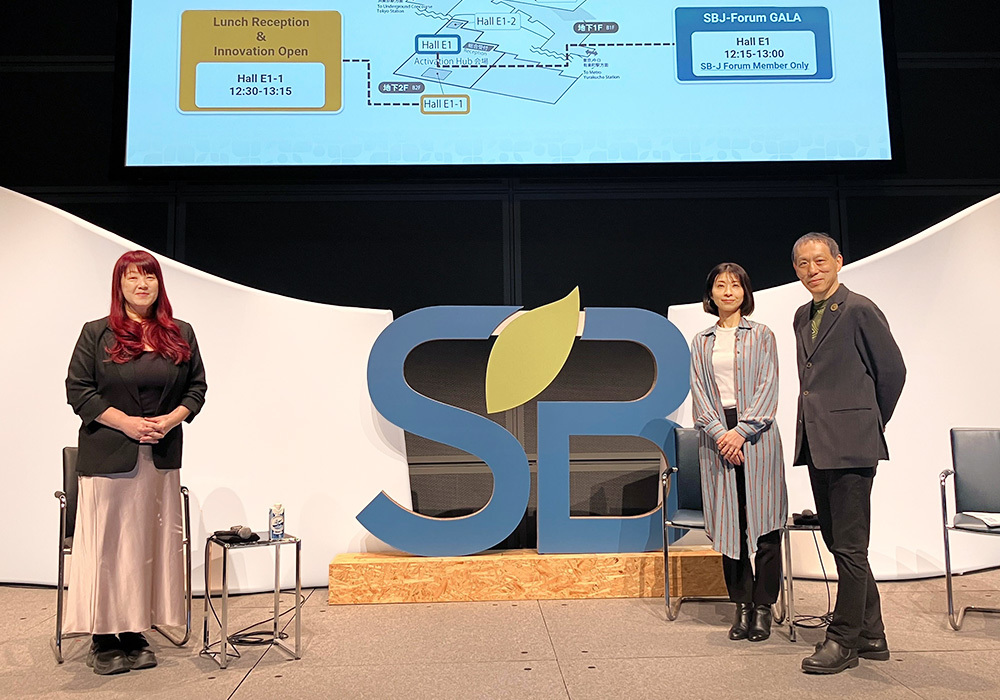
(From left) Ms. Takeshima, Ms. Ohtake, Mr. Hasegawa
Why Companies Pursue Sustainability
Takeshima: In January this year, the UN announced that last year's global average temperature rose 1.5°C above pre-industrial levels. Against this backdrop, when discussing why companies should pursue sustainability, I always emphasize three risks of inaction.
The first is "business risk." Companies may struggle to secure investment and financing from investors and financial institutions, leading to operational difficulties.
The second is "human capital risk." It becomes difficult to retain and secure talented, young personnel with a high awareness of sustainability, threatening the company's operational foundation.
The third is "brand risk." Companies risk being excluded by business partners or consumers, ultimately becoming unable to survive. This awareness is rapidly increasing, and brands that are not chosen by customers cannot generate profits.
Advertising and media placements are often categorized as Scope 3, Category 1 (raw materials) for companies. If companies aim to reduce CO2 emissions across their entire supply chain, the advertising and media industry must also make efforts. In this session, I'd like to discuss what the advertising and media industry is already undertaking.

What are the decarbonization initiatives by the advertising and media industry?
Ohtake: Our company operates 20 brands, including magazines like Fujingaho and ELLE JAPON, digital media, and e-commerce in fashion, wellness, and food. Recently, we've also been focusing on B2B solution businesses.
Regarding our own environmental initiatives, for magazines, we started using paper and ink with lower environmental impact. Since 2019, aiming for plastic reduction, we discontinued the plastic cover coating we had previously used. These measures have reduced our plastic usage by about 80% compared to 2019.
Next, I'll introduce three decarbonization projects related to advertising. First, we calculated the carbon footprint generated per magazine produced. We added a QR code to the colophon page (which lists publisher and editor information) so interested readers can access detailed information about the calculation method and scope of the carbon footprint.
The second is calculating the carbon footprint generated during event hosting. We started this in 2023. We have continued calculating footprints for our hosted events and improved accuracy, so we plan to launch an event calculation advertising plan for B2B clients in March 2025.
Third is calculating greenhouse gas emissions from the entire content production process. We started this in 2024 and are advancing the project with participation from all media outlets, including magazines and digital media.
The first major hurdle we encountered while advancing these initiatives was understanding their importance while also recognizing the significant additional costs and time required. Beyond needing specialized knowledge, there was a strong sense that it must be done correctly, making it difficult to identify clear benefits or a compelling starting point.
Through this experience, I realized the importance of lowering the barriers and costs when starting. Even a small step is better than none—just take that first step. In hindsight, I truly felt that the world looks completely different after taking that step than it did before.
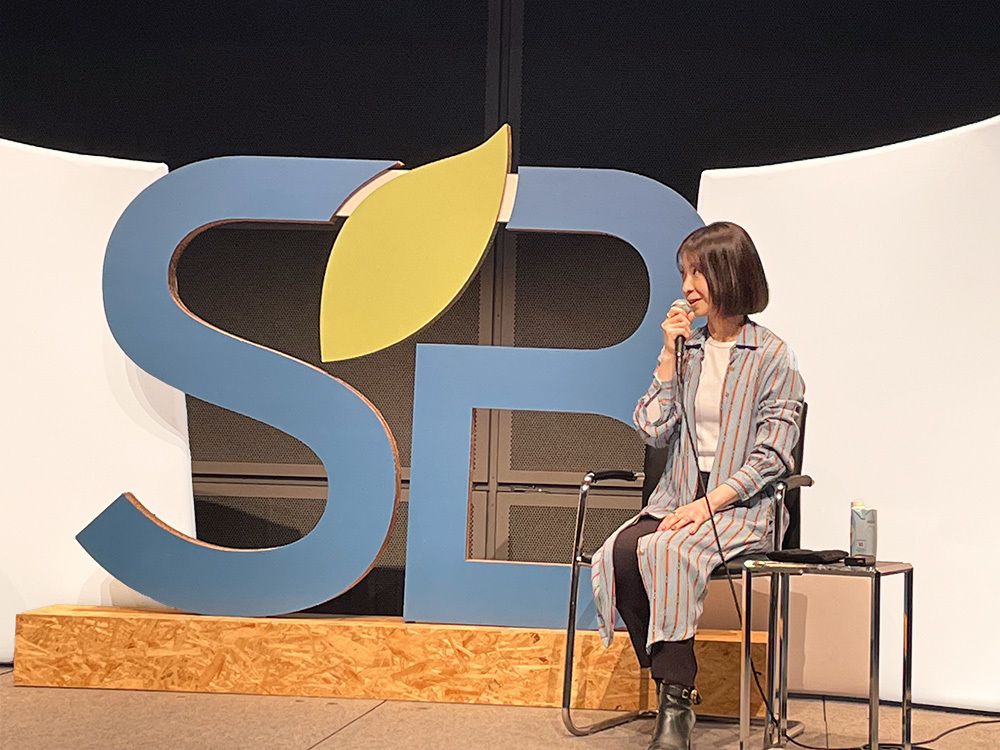
Hasegawa: Dentsu Creative Pictures Inc., where I work, is a company that produces various types of advertising content. We were the first in Japan to handle TV commercials and continue to produce many today.
Let me share two of our initiatives. The first is the introduction of virtual production, which directly reduces CO2 emissions. Our studio features a large permanent LED panel. Virtual production involves projecting footage of actual locations or CG-created sets onto this panel for filming.
In traditional film production, location shoots generate significant CO2 emissions from transportation vehicles, planes, trains, and lodging. We believe virtual production has great potential to reduce these emissions and also cut down on materials used for physical sets.
The second initiative is the development of a Carbon Calculator to visualize CO2 emissions and evaluate reductions. We call it the Carbon Calculator for Movie Production (CCMP), developed in 2022. We have begun using CCMP to calculate emissions while producing TV commercials and videos. More recently, we have expanded its use to calculate emissions for longer-form content like films and dramas.
Calculations for NHK's Taiga drama "Berabou: The Tale of Tsutae's Prosperity and Decline" confirmed that utilizing virtual production can significantly reduce CO2 emissions. We have also calculated CO2 emissions for the production processes of "Broken Rage" (directed by Takeshi Kitano), produced by Amazon MGM Studios, and "Silent Fleet: The Battle of the Arctic Ocean" (directed by Kohei Yoshino). While many challenges and difficulties remain to be resolved, we recognized that nothing would start or progress unless we took the first step. Therefore, our greatest innovation was likely initiating this effort not alone, but in a cross-industry collaboration with Tohokushinsha Film Corporation and Hibino Corporation, renowned for large LED displays.
A shift in awareness among on-site employees and staff
Ohtake: The first major change through the calculation project was the sudden emergence of a sense of ownership. Even before the project, I believe each employee had some interest or knowledge about sustainability, but many might have felt it was someone else's problem.
By actually joining the project and engaging in the calculations, they experienced firsthand which processes generate the most greenhouse gas emissions, how they could be reduced, or why they couldn't be reduced. I witnessed how this instantly made it their personal concern. And I feel that employees who underwent this change subsequently showed a different attitude and level of enthusiasm in their subsequent efforts.
Hasegawa: Motivating the field staff requires genuine commitment from those in supervisory roles. I believe Mr. Otake advanced the project precisely from that position. While we have many staff members in departments like Engineering and Lighting, having supervisors communicate with their teams beforehand makes it much easier to convey specific procedures and details.
Without calculation, you can't even reach the starting line of global business
Hasegawa: I believe calculation tools have a public good aspect to them, so it would be ideal for the entire industry to use them as collaborative tools. By having many people use them, I think we can contribute to reducing greenhouse gases across the entire industry.
On the other hand, initiatives for CO2 reduction, including virtual production, are areas of competition driven by each company's efforts. I believe it's best for each company to focus on these individually. Either way, these efforts are also about making advertising itself and advertising agencies entities chosen by corporate clients, so they will ultimately connect to business.
Ohtake: Regarding sustainability advertising placements and event hosting, some clients decide to place ads with us because they resonate with our company's and media's stance. Regarding calculations, global sustainability disclosure is about to begin. At that point, if you lack calculation knowledge or haven't actually performed calculations, you won't even be at the starting line for doing business globally.
The decarbonization efforts across the entire advertising and media industry are just beginning.
Takashima: In October 2023, the Dentsu Group launched the Decarbonization Initiative for Marketing (DIM) (※1), an initiative for the domestic advertising industry standard aimed at visualizing and reducing greenhouse gas emissions.
※1: A decarbonization initiative for the marketing sector launched to promote the visualization of GHG emissions within related supply chains and reduce GHG emissions generated by marketing communications in Japan.
URL: https://www.group.dentsu.com/jp/news/release/001051.html
The entire industry is now beginning to take action to raise awareness about decarbonization efforts, share information, and establish common rules and operational methods for policies. While companies are competitors in their day-to-day business, they recognize that decarbonization and sustainability are issues that cannot be tackled by individual companies alone. This has led to a movement for the entire industry to work together. Efforts are advancing not only in advertising and media placements but also across various areas like promotions and events.
Hasegawa: I feel the advertising and media industry's powerful communication capabilities haven't yet been fully leveraged for decarbonization. An industry with such influence has a responsibility to take the lead. Ideally, we want to make this year the starting point for our industry's decarbonization.
Ohtake: I believe that when the entire media sector takes action and makes it their own cause, the weight of the information we disseminate and how we convey it will change. I expect that media companies becoming sustainable themselves will not only transform their own practices but also significantly influence the companies and the general public who receive the information. This comes with great responsibility, so we must never forget this purpose and move forward united as the media.
Takashima: Many of you gathered at the Sustainable Brands International Conference are likely already actively engaged in sustainability and decarbonization. However, I believe that to achieve these goals, it is crucial to change the awareness and actions of consumers and shift the overall mood of society.
Advertising and media, being so familiar to everyone, can contribute greatly to this. This also connects to the industry fulfilling its responsibility.
Learning about these initiatives may also slightly alter your perspective on advertising and media. If many of you gather with a desire to collaborate or undertake trials together, I believe our momentum will accelerate even further.












